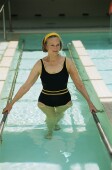
TUESDAY, April 9 (HealthDay News) — Older women who are physically active have lower levels of estrogen and its breakdown products in their bodies, according to a new study, perhaps explaining why exercise may reduce breast cancer risk.
Researchers have long linked exercise with lower breast cancer risk for women past menopause, believing it works partly by lowering their estrogen levels. Higher estrogen levels can raise breast cancer risk.
The new study provides more clues as to how the exercise may be protective, said Cher Dallal, a cancer prevention fellow at the U.S. National Cancer Institute. She is scheduled to present the findings Tuesday at the American Association for Cancer Research’s annual meeting in Washington, D.C.
Because this study is presented at a medical meeting, the data and conclusions should be viewed as preliminary until published in a peer-reviewed journal.
“Our aim was to try to better understand how physical activity may affect levels of estrogen,” Dallal said. She evaluated 540 Polish women, aged 40 to 74, who were enrolled as healthy control patients in the NCI Polish Breast Cancer Study. None of the patients was on hormone therapy.
The women engaged in a range of physical activity. For seven days, they wore a device called an accelerometer on their waist while awake, which measured overall activity. The women also collected 12-hour urine samples.
Dallal measured the hormones estradiol and estrone, along with different estrogen breakdown products, or metabolites, in the urine. “Physical activity was associated with lower levels of the main estrogens,” she said. Activity also was associated with increased metabolism of some of the breakdown products, she found.
“Increased overall activity appears to increase the metabolism of estrogen,” she said. “This is the first time we have been able to assess these 15 metabolites.”
Using the accelerometers gives a much more accurate picture of activity during the day than other methods, such as having women recall their exercise activity, said Leslie Bernstein, a professor and director of cancer etiology at the City of Hope Comprehensive Cancer Center, in Duarte, Calif.
Bernstein was not involved in this study, but was one of the first to study exercise as a way to reduce estrogen exposure and breast cancer risk. The new study, she said, “just adds evidence to say that this is one mechanism by which physical activity reduces your risk of breast cancer. You have less excretion [of the hormones] so it means you are producing less. [However], it’s still not proven.”
But, she said, “we know for breast cancer [risk], hormones are important. This is the first time we have strong evidence that measured physical activity reduces hormone levels. It helps us understand what’s going on and how it’s working.”
It doesn’t mean, however, that physical activity doesn’t also reduce risk in other ways, such as improving insulin metabolism, she said. Higher insulin levels have been linked with some cancers, including breast cancers.
Exercise also helps with weight control. Most estrogen comes from fat tissue after menopause, and having more fat tissue raises estrogen levels and, in turn, breast cancer risk.
Some researchers are also looking at whether physical activity can improve your ability to repair DNA, which would perhaps explains the reduced cancer risk, Bernstein said.
The take-home message for women from the new research is to exercise, Bernstein said. Women who haven’t been active should check in first with their doctor, and then, after getting the go-ahead from their doctor, engage in exercise that “puts some stress on the body,” such as brisk walking, she suggested.
More information
To learn more about breast cancer risk, visit the American Cancer Society.

